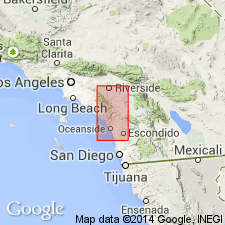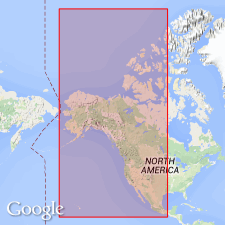
- Usage in publication:
-
- Mt. Hole granodiorite*
- Modifications:
-
- Named
- Dominant lithology:
-
- Granodiorite
- AAPG geologic province:
-
- Peninsular Ranges province
Summary:
Named for characteristic outcrops on Mt. Hole, northeast of Corona, Riverside Co, CA. [Name Mount [note spelling] Hole granodiorite first used by Larsen and Keevil (1947) in study of batholith of southern CA]. Rock weathers into huge light-colored boulders of disintegration. Carries inclusions of Woodson Mountain granodiorite (new); therefore younger than Woodson Mountain. Chemical analysis included. Map legend shows age as Cretaceous.
Source: GNU records (USGS DDS-6; Menlo GNULEX).

- Usage in publication:
-
- Mount Hole granodiorite*
- Modifications:
-
- Geochronologic dating
- AAPG geologic province:
-
- Peninsular Ranges province
Summary:
Sample of Mount Hole granodiorite from east of Mount Hole yielded Pb-alpha age of approximately 95 Ma. Twenty-five age determinations on rocks from batholith of southern CA, ranging from tonalite to granite, give mean age of 110 +/-13 Ma; geologic evidence indicates this batholith is early Late Cretaceous in age.
Source: GNU records (USGS DDS-6; Menlo GNULEX).
For more information, please contact Nancy Stamm, Geologic Names Committee Secretary.
Asterisk (*) indicates published by U.S. Geological Survey authors.
"No current usage" (†) implies that a name has been abandoned or has fallen into disuse. Former usage and, if known, replacement name given in parentheses ( ).
Slash (/) indicates name conflicts with nomenclatural guidelines (CSN, 1933; ACSN, 1961, 1970; NACSN, 1983, 2005, 2021). May be explained within brackets ([ ]).

